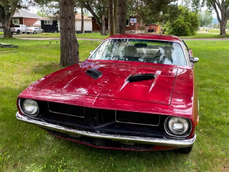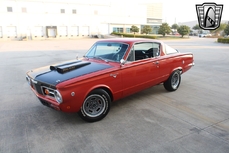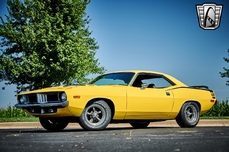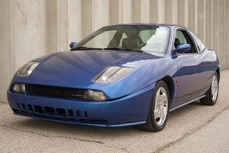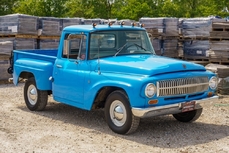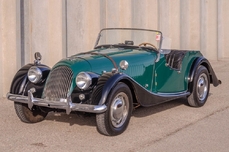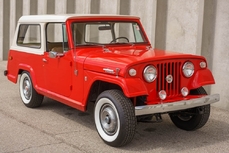Plymouth Barracuda 426 Hemi V-8 1971
General description :
1971 Plymouth Barracuda Hemi Tribute
To be featured in a future episode of Gas Monkey’s Fast N Loud this current season
Full professional nut and bolt restoration completed in 2004 by Highland Automotive in Highland, New York
Sassy Grass Green (code FJ6) with black billboard graphics (code V6X) and black leather interior (code SRX9)
Genuine 426 CID Hemi V-8 with dual four-barrel carburetors making 425 horsepower!
Four-speed manual transmission (code D21) with pistol grip shifter and Dana 60 Sure Grip rear differential (code D91)
Correct Shaker hood with hold-down pins
Bucket seats and center console
Rallye gauge cluster
Power brakes with front discs
Black front air dam, rear wing, road lightsand rear window louvers
Rallye wheels and Goodyear Polyglas radials
Documentation includes original owners manual, original full-line 1971 Plymouth brochure, a binder of photos chronicling the cars frame-off, nut and bolt restoration
Lookin to hook a big Mopar fish? We have the proper bait to lure you here at MotoeXotica Classic Cars, a 1971 Sassy Grass Green Plymouth Barracuda Hemi Tribute. This car is a stunning tribute to extreme correct standards to what could be had if you walked into a Plymouth dealership in 1971 and ordered nearly the full E-body Barracuda performance menu. This awesome Cuda is to be featured in a future episode of Gas Monkey’s Fast N Loud this current season.
It started life as a 1971 Barracuda two-door hardtop with a 383 CID V-8 engine and a four-speed manual transmission made in Chryslers Hamtramck, Michigan factory in September 1970. It was delivered to Grand Spaulding Auto Sales in Chicago, Illinois.
Highland Automotive in Highland, New York performed a frame-off nut-and-bolt restoration on this example in 2004. Re-finished in period-specific Sassy Grass Green (code FJ6), with black billboard graphics (code V6X), the cars paint and trim are in excellent condition and exactly what you would expect from a full professional nut and bolt restoration. Its glass panels are clear and intact and its lights are clear and haze-free, including the fog, or road lights.
This Cuda rolls on Goodyear Polyglas GT tires, F60-15, at all four corners, surrounding factory alloy wheels with caps and beauty rings. The cars bodywork is solid and straight, the engine bay is extremely tidy, the bumpers fit well to the body; the battery is in good order, as is the trunk.
Inaide, the black interior is in excellent order overall. The high-back front leather bucket seats and rear bench, carpet, headliner, instrument panel with woodgrain appliqués with full instrumentation, three-spoke, rim-blow wood rimmed steering wheel, inner door panels, center console and pistol grip shift lever all look fantastic. Along with the very good mirror glass, completing the interior is a factory AM/FM stereo.
A 426 CID Hemi V-8 engine with dual four-barrel carburetors making 425 horsepower and was a brand new motor from Mopar performance in 2004 which would cost you around $40k today in the engine alone! The Hemi is backed by a four-speed manual transmission (code D21) and a heavy-duty Dana 60 Sure Grip differential (code D91) with a 9.75-inch ring gear. Driver convenience features include power brakes with front discs and PLENTY of horsepower!
The Barracuda was changed slightly for 1971, with a new grille and taillights, seat, and trim differences. This would be the only year that the Barracuda would have fourheadlights(which the Challenger had for all five years of their concurrent run), and also the only year of the fender gills on the Cuda model.
The 1971 Barracuda engine options would remain the same as that of the 1970 model, except that the 340 Six-Barrel was gone, and the four-barrel carbureted 440 V-8 engine was no longer on the option list but could be had via a special order and perhaps a dozen cars were built with it installed; otherwise the 440-powered Barracudas had a six-barrel carburetor setup instead.
In 1970 and 1971 only, theshaker hood, elastomeric (rubber) colored bumpers, and the Spicer-builtDana 60rear axle were available. The elastomeric (rubber) colored bumpers were available as a front-only option, code A21, or as a front and rear combination, option code A22. The heavy-duty (and heavy) Dana 60, with a 9.75-inch ring gear, was standard equipment withmanual transmissionsand 440 six-barrel and 426 Hemi engines and was optional on those with theautomatic transmission.
Documentation includes original owners manual, original full-line 1971 Plymouth brochure, a binder of photos chronicling the cars frame-off, nut and bolt restoration and miscellaneous documents.
Competition to this Plymouth in 1971 included Chevrolets Camaro, Dodges Challenger, Fords Mustang, Mercurys Cougar and Pontiacs Firebird.
This car is currently located at our facility in St. Louis, Missouri. Current mileage on the odometer shows 4 miles. It is sold as is, where is, on a clean and clear, mileage exempt title. GET OUT AND DRIVE!!!
PLEASE CLICK HERE TO VIEW OUR YOUTUBE VIDEO!
VIN: BS23N1B150230
http://www.motoexotica.com/inventory/listing/1971-plymouth-barracuda-hemi-tribute/
1971 Plymouth Barracuda 426 Hemi V-8 is listed sold on ClassicDigest in Fenton (St. Louis) by for $119900.
Car Facts
Car type : Car Make : Plymouth Model : Barracuda Model Version : 426 Hemi V-8 Engine size : 0.0 Model Year : 1971 Sub type : Coupé Location : Fenton (St. Louis)
Sold
Seller Information
Sold
People who viewed this Plymouth Barracuda also viewed similar Plymouth listed at ClassicDigest
Other cars listed for sale by this dealer
About Plymouth
The Plymouth brand had a significant impact on the automotive industry from its inception to its eventual discontinuation. Here is an overview of Plymouth, covering its history, notable models, and specifications:Early Years and Foundation:
Origins (1928): Plymouth was introduced by Chrysler Corporation as an affordable mid-level brand, targeting budget-conscious consumers.
Success Factors: It gained popularity due to its dependable engineering, affordability, and clever marketing campaigns.
Notable Models:
Plymouth Road Runner (1968-1980):
Iconic Muscle Car: Known for its performance, affordability, and minimalist design.
Specifications: Offered various V8 engine options with power ranging from 335 to 390+ horsepower.
Plymouth Barracuda (1964-1974):
Muscle Car Competitor: Positioned as a sporty competitor in the muscle car segment.
Specs: Engine options included V8s with power output varying between 145 to 425+ horsepower.
Plymouth Fury (1955-1978):
Longevity: One of Plymouth's longest-produced models, available in various body styles.
Technical Features: Engine options included V8s with power ranging from 215 to 375+ horsepower.
Plymouth Valiant (1960-1976):
Compact Car: Introduced as a compact car, known for its durability and reliability.
Engine Specifications: Featured inline-six and V8 engines with power ranging from 100 to 235+ horsepower.
Decline and Demise:
Later Years: Plymouth faced challenges due to brand dilution within Chrysler Corporation and increasing competition from other brands.
Discontinuation: The brand struggled in the 1990s amid corporate restructuring and declining sales. Plymouth ceased production in 2001 as part of DaimlerChrysler's streamlining efforts.
Legacy and Impact:
Plymouth's legacy lies in its contributions to the American automotive landscape, offering reliable, affordable, and stylish vehicles. While it faced challenges in its later years and ultimately ceased production, several of its iconic models, especially those in the muscle car era, remain celebrated among collectors and enthusiasts, leaving an enduring mark on automotive history.




